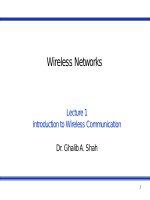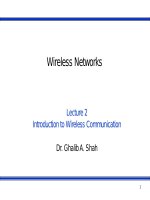Wireless networks - Lecture 23: WCDMA (Part 3)
Bạn đang xem bản rút gọn của tài liệu. Xem và tải ngay bản đầy đủ của tài liệu tại đây (168.6 KB, 23 trang )
Wireless Networks
Lecture 23
WCDMA (Part III)
Dr. Ghalib A. Shah
1
Outlines
Compressed mode measurements
Handover measurements
► Intra-mode
► Inter-mode
► Inter-system
WCDMA packet data access
Transport channels for packet data
► Common, dedicated, shared
Packet scheduling algorithms
► Time division scheduling
► Code division scheduling
► Transmission Power-based scheduling
2
Last Lecture Review
Spreading and Scrambling
Transport Channels
Physical Channels
► UL Dedicated
Signalling
Physical Layer Procedures
► RACH Operation
► Cell Searching
► Power Control
• Open Fast loop
• Closed Loop
3
Compressed Mode Measurements
The compressed mode is needed when making
measurement from another frequency without
full dual receiver terminal.
The intention is not to loose data but to
compress
The transmission and reception are halted for a
short time to perform measurements on the
other frequencies.
4
Compressed Mode Measurements
5
Three methods for compressed mode:
► Lowering the data rate from higher layers because they have
knowledge of compressed mode schedule.
► Increasing the data rate by changing the spreading factor.
► Reducing the symbol rate by puncturing at the physical layer
multiplexing chain but limited to rather short Transmission Gap
Lengths (TGL).
More power is needed during compressed mode.
No power control during compressed mode. Large step
size is used after a compressed frame to allow the
power level to converge more quickly to the correct
value after the break.
6
Transmission Gap length (TGL)
The specified TGL are 3,4,7,10 and 14 slots
► TGL lengths 3, 4 and 7 can be obtained with both single and
double frame methods
► TGL 10 or 14 only obtained with double frame method allowing
minimizing the impact during a single frame
Frame 2
Frame 1
TGL
► Very short values of TGL (1 or 2) is excluded the hardware
requires some time to switch to different frequency and not as
much time for measurements
► Link performance does not degrade much if the terminal is not
at the cell edge since there is room to compensate with fast
power control.
7
Handover measurements
Intra-mode handover
► Include soft handover, softer handover and hard
handover.
Inter-mode handover
► Handover to the UTRA TDD mode.
Inter-system handover
► Handover to other system, such as GSM.
8
Intra-Mode Handover
Rely on the Ec/No measurement performed from the CPICH.
The quantities defined that can be measured by the terminal from
CPICH are
►
►
►
Additional information for soft handover purposes is the relative
timing between the cells to allow coherent combining in the RAKE
receiver, otherwise would be difficult to combine.
►
►
►
Received Signal Code Power (RSCP): received power on one code
after de-spreading
RSSI: wideband received power within channel b/w
Ec/No, representing RSCP/RSSI
If cells are within 10ms window, the relative timing can be found from
primary scrambling code phase
Otherwise terminals need to decode System Frame Number from
primary CCPCH that takes time and may suffer errors.
The 10 ms window has no relevance when timing information provided
in neighboring cells list.
For hard handover, timing info is not needed and different
frequency measurements can be done with aid of compressed
mode
9
Inter-Mode Handover
Dual mode FDD-TDD terminals operating in
FDD measure power level from TDD cells
available
The TDD CCPCH bursts sent twice during
10ms frame can be used for measurement.
Since TDD cells are synchronized, finding one
slot means that other TDD cells have roughly
same timing for their burst.
10
Inter-System handover
Terminal receives GSM synch channel during
compressed frames in UTRA FDD.
GSM 1800 set special requirements for
compressed mode
11
Packet Data Access
Four basic types of traffic classes
► Conversational class ->real-time connection,
performed between human users, really low delay,
nearly symmetric, e.g., speech
► Streaming class ->real-time connection, transferring
data as a steady and continuous, low delay,
asymmetric, e.g., video
► Interactive class ->non-real-time packet data,
response requested from other end-user, reasonable
round-trip delay, e.g., Web browsing
► Background class ->non-real-time packet data, no
immediate action expected, less sensitive to delivery
time, e.g. e-mail
12
Types of Data Packet Traffic
Packet data traffic is a non-real-time packet services
including Interactive and Background traffic classes.
Their properties are
► Packet data is bursty. Sometimes a large amount of data is
transferred. At the other times no data is sent. Thus, the
required bit rate can change rapidly.
► Packet data tolerates longer delay than real-time services. It is
controllable traffic from the RNC; thus, RNC can decide when
and how to send the data.
► Packets can be transmitted by the radio link control layer which
provides retransmission and error correction services.
Therefore, it allows high frame error rate with low transmission
power.
One example of packet data traffic is ETSI packet data
model for web browsing.
13
Characteristics of packet service session
►
Session arrival process, number of packet calls per session, reading
time, number of packets within a call, inter-arrival time in a call, packet
size
Packet service session
Packet call
Time
Reading time
Packet size
Arrival interval
14
WCDMA packet Access
In WCDMA packet allocations, e.g., time and bit rate,
are controlled by the packet scheduler (PS) located in
RNC. PS functions include:
► Properly allocate the available resources (time, code or power)
between the packet data users
► Decide the allocated bit rates and the length of the allocation
► Decide to use the transport channel
► Monitor the packet allocations and the systems loads
PS can allocate common, dedicated or shared
channels to packet data users. It can also change the
bit rate during active connection.
PS can increase or decrease the network load by
increasing or decreasing the bit rates of the packet
bearers respectively.
15
Transport Channels for Data Packet Access
Common channels - RACH in the uplink and
FACH in the downlink
► One or few RACH or FACH per sector
► Low setup time
► No feedback channel ->no fast closed loop power
control, no soft handover, use fixed power
► Poor link-level radio performance and generated
more interference
► Suitable for small data amounts
16
Dedicated Channel - DCH in the uplink and
downlink
►
►
►
►
►
►
Use fast power control and soft handover
Longer setup time
Up to 2 Mbps
Suitable for large data amounts
Not suitable for bursty data
In case of changing bit rate in the downlink, the
downlink orthogonal code is reserved according to
maximum bit rate.
17
Shared Channel - uplink and downlink
► A single orthogonal code is shared with many packet
user with established DCH in time division manner code efficient
► Fast allocation and rate modification (frame-byframe basis)
► Suitable for large data amounts and bursty data
► Use fast power control, but no soft handover
18
Pac ke t S c he duling Alg o rithms
In WCDMA packet scheduling algorithms can be done
in two ways, in a time or code division manner.
Time division scheduling
► One user is allocated a channel at a time (10 ms frame)
► All available capacity can be allocated to that user
► High data rate for a short period of time
Code division scheduling
► Many users are allocated the channels simultaneously
► Low data rate for a long period of time
► Increase more users, each user’s bit rate is decreased
19
Time Division Scheduling
Advantages
► High bit rate required less energy per bit
► Less interference
► Shorter delay due to high bit rate
20
Code Division Scheduling
Advantages
► Resources are in full usage due to longer
transmission time
► Small variation in interference level
21
Trans mis s io n Po we rbas e d S c he duling
Users close to the BS requires less
transmission power and can get a higher bit
rate, whereas users at the cell edge could get
lower bit rate
Advantages
► Minimize the average power sent per bit
► Less interference
► Increase the throughput
Disadvantages
► Accurate power estimation
► Unfair resource allocation
22
Summary
Compressed mode measurements
Handover measurements
► Intra-mode
► Inter-mode
► Inter-system
WCDMA packet data access
Transport channels for packet data
► Common, dedicated, shared
Packet scheduling algorithms
► Time division scheduling
► Code division scheduling
► Transmission Power-based scheduling
Next Lecture
► cdma2000
23









